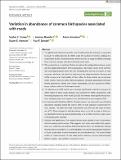Files in this item
Variation in abundances of common bird species associated with roads
Item metadata
| dc.contributor.author | Cooke, Sophia C. | |
| dc.contributor.author | Balmford, Andrew | |
| dc.contributor.author | Johnston, Alison | |
| dc.contributor.author | Newson, Stuart E. | |
| dc.contributor.author | Donald, Paul F. | |
| dc.date.accessioned | 2021-11-26T13:30:12Z | |
| dc.date.available | 2021-11-26T13:30:12Z | |
| dc.date.issued | 2020-07 | |
| dc.identifier | 276798268 | |
| dc.identifier | 27ce46a8-1698-49aa-a0c0-f8bce66249ec | |
| dc.identifier | 000527694300001 | |
| dc.identifier | 85083701391 | |
| dc.identifier.citation | Cooke , S C , Balmford , A , Johnston , A , Newson , S E & Donald , P F 2020 , ' Variation in abundances of common bird species associated with roads ' , Journal of Applied Ecology , vol. 57 , no. 7 , pp. 1271-1282 . https://doi.org/10.1111/1365-2664.13614 | en |
| dc.identifier.issn | 0021-8901 | |
| dc.identifier.other | ORCID: /0000-0001-8221-013X/work/103866002 | |
| dc.identifier.uri | https://hdl.handle.net/10023/24410 | |
| dc.description | Funding: Natural Environment Research Council. Grant Number: RG81247. | en |
| dc.description.abstract | 1. The global road network, currently over 45 million lane-km in length, is expected to reach 70 million lane-km by 2050, while the number of vehicles utilizing it is expected to double. Roads have been shown to affect a range of wildlife, including birds, but most studies have been relatively small scale. 2. We use data from across Great Britain to analyse the relationships between roads and the spatial distributions of bird populations. We model counts of 51 common and widespread species from the U.K. Breeding Bird Survey in relation to road exposure, which we calculated for each count site using the density, distance and traffic volume of all roads within a 5-km radius. In these models, we incorporate other factors known to affect bird populations, including agricultural intensity, human population, habitat and climate. Importantly, we also account for differences in detectability of birds near to roads. 3. The abundances of 30 species were strongly significantly related to exposure to either major or minor roads. Species were generally in higher abundances with increasing exposure to minor roads (20/28). In contrast, most significant associations between major road exposure and bird abundance were negative (7/8). 4. For species with significant effects of road exposure, we assessed how estimated abundance changed across the central 50% of road exposure experienced for each species. The mean decrease in abundance was 19% and the mean increase was 47%. These changes in bird abundance were up to half as large as those associated with increasing agricultural intensity, a factor often cited as a major cause of bird population changes. 5. Synthesis and applications. Our research shows many species to vary in abundance with increasing road exposure. This suggests that roads may modify bird populations on a national scale and that their potential as drivers of biodiversity change should not be overlooked. Our work highlights the need for appropriate mitigation of roads, particularly in areas important for avian biodiversity. This could include efforts to reduce impacts of road noise and/or collisions, such as reduced speed limits or quieter road surfaces in sensitive areas. | |
| dc.format.extent | 12 | |
| dc.format.extent | 1203146 | |
| dc.language.iso | eng | |
| dc.relation.ispartof | Journal of Applied Ecology | en |
| dc.subject | Anthropogenic noise | en |
| dc.subject | Bird populations | en |
| dc.subject | Breeding Bird Survey | en |
| dc.subject | Great Britain | en |
| dc.subject | Infrastructure impacts | en |
| dc.subject | Road ecology | en |
| dc.subject | Road exposure | en |
| dc.subject | GE Environmental Sciences | en |
| dc.subject | QH301 Biology | en |
| dc.subject | DAS | en |
| dc.subject.lcc | GE | en |
| dc.subject.lcc | QH301 | en |
| dc.title | Variation in abundances of common bird species associated with roads | en |
| dc.type | Journal article | en |
| dc.contributor.institution | University of St Andrews. Statistics | en |
| dc.contributor.institution | University of St Andrews. Centre for Research into Ecological & Environmental Modelling | en |
| dc.identifier.doi | https://doi.org/10.1111/1365-2664.13614 | |
| dc.description.status | Peer reviewed | en |
This item appears in the following Collection(s)
Items in the St Andrews Research Repository are protected by copyright, with all rights reserved, unless otherwise indicated.

